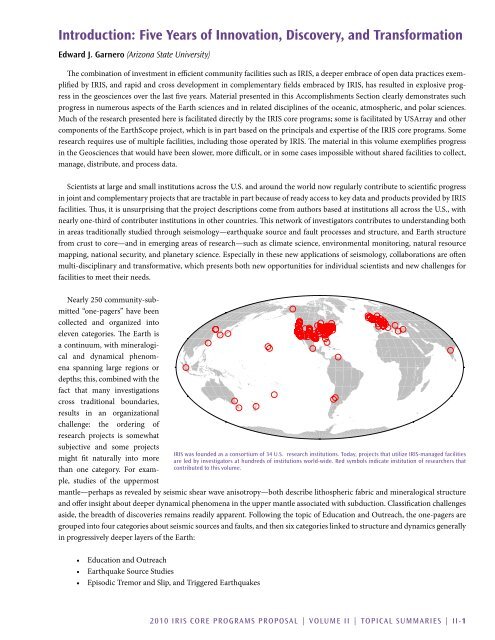Download Volume II Accomplisments (28 Mb pdf). - IRIS
Download Volume II Accomplisments (28 Mb pdf). - IRIS
Download Volume II Accomplisments (28 Mb pdf). - IRIS
Create successful ePaper yourself
Turn your PDF publications into a flip-book with our unique Google optimized e-Paper software.
Introduction: Five Years of Innovation, Discovery, and Transformation<br />
Edward J. Garnero (Arizona State University)<br />
The combination of investment in efficient community facilities such as <strong>IRIS</strong>, a deeper embrace of open data practices exemplified<br />
by <strong>IRIS</strong>, and rapid and cross development in complementary fields embraced by <strong>IRIS</strong>, has resulted in explosive progress<br />
in the geosciences over the last five years. Material presented in this Accomplishments Section clearly demonstrates such<br />
progress in numerous aspects of the Earth sciences and in related disciplines of the oceanic, atmospheric, and polar sciences.<br />
Much of the research presented here is facilitated directly by the <strong>IRIS</strong> core programs; some is facilitated by USArray and other<br />
components of the EarthScope project, which is in part based on the principals and expertise of the <strong>IRIS</strong> core programs. Some<br />
research requires use of multiple facilities, including those operated by <strong>IRIS</strong>. The material in this volume exemplifies progress<br />
in the Geosciences that would have been slower, more difficult, or in some cases impossible without shared facilities to collect,<br />
manage, distribute, and process data.<br />
Scientists at large and small institutions across the U.S. and around the world now regularly contribute to scientific progress<br />
in joint and complementary projects that are tractable in part because of ready access to key data and products provided by <strong>IRIS</strong><br />
facilities. Thus, it is unsurprising that the project descriptions come from authors based at institutions all across the U.S., with<br />
nearly one-third of contributer institutions in other countries. This network of investigators contributes to understanding both<br />
in areas traditionally studied through seismology—earthquake source and fault processes and structure, and Earth structure<br />
from crust to core—and in emerging areas of research—such as climate science, environmental monitoring, natural resource<br />
mapping, national security, and planetary science. Especially in these new applications of seismology, collaborations are often<br />
multi-disciplinary and transformative, which presents both new opportunities for individual scientists and new challenges for<br />
facilities to meet their needs.<br />
Nearly 250 community-submitted<br />
“one-pagers” have been<br />
collected and organized into<br />
eleven categories. The Earth is<br />
a continuum, with mineralogical<br />
and dynamical phenomena<br />
spanning large regions or<br />
depths; this, combined with the<br />
fact that many investigations<br />
cross traditional boundaries,<br />
results in an organizational<br />
challenge: the ordering of<br />
research projects is somewhat<br />
subjective and some projects<br />
might fit naturally into more<br />
than one category. For example,<br />
studies of the uppermost<br />
mantle—perhaps as revealed by seismic shear wave anisotropy—both describe lithospheric fabric and mineralogical structure<br />
and offer insight about deeper dynamical phenomena in the upper mantle associated with subduction. Classification challenges<br />
aside, the breadth of discoveries remains readily apparent. Following the topic of Education and Outreach, the one-pagers are<br />
grouped into four categories about seismic sources and faults, and then six categories linked to structure and dynamics generally<br />
in progressively deeper layers of the Earth:<br />
• Education and Outreach<br />
• Earthquake Source Studies<br />
• Episodic Tremor and Slip, and Triggered Earthquakes<br />
<strong>IRIS</strong> was founded as a consortium of 34 U.S. research institutions. Today, projects that utilize <strong>IRIS</strong>-managed facilities<br />
are led by investigators at hundreds of institutions world-wide. Red symbols indicate institution of researchers that<br />
contributed to this volume.<br />
2010 <strong>IRIS</strong> Core Programs Proposal | <strong>Volume</strong> <strong>II</strong> | Topical Summaries | <strong>II</strong>-1
















